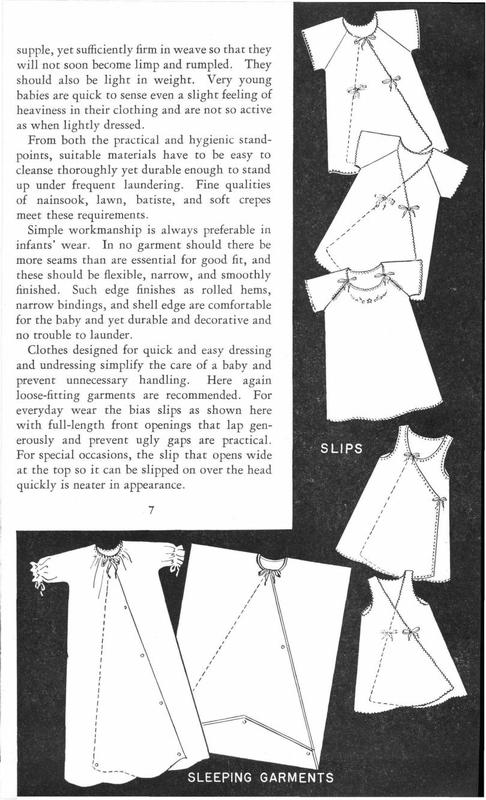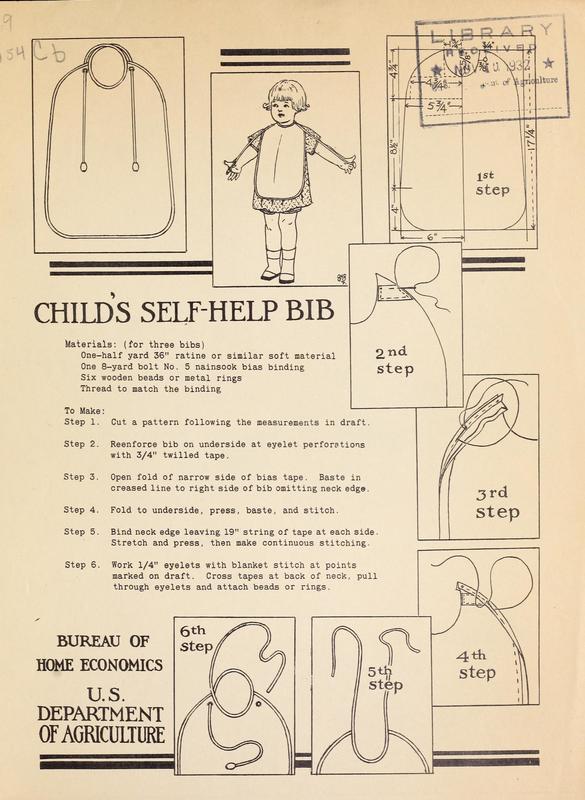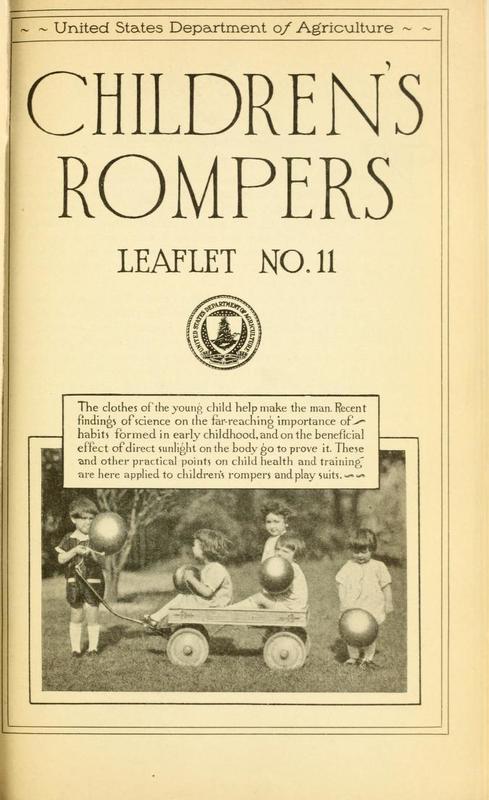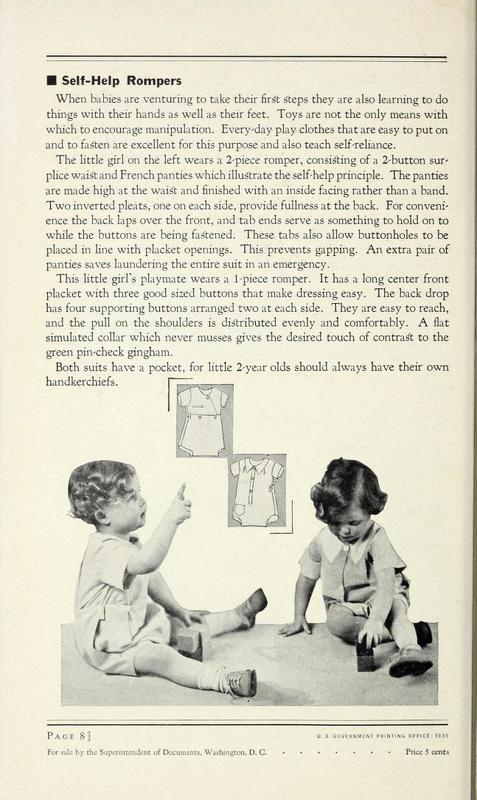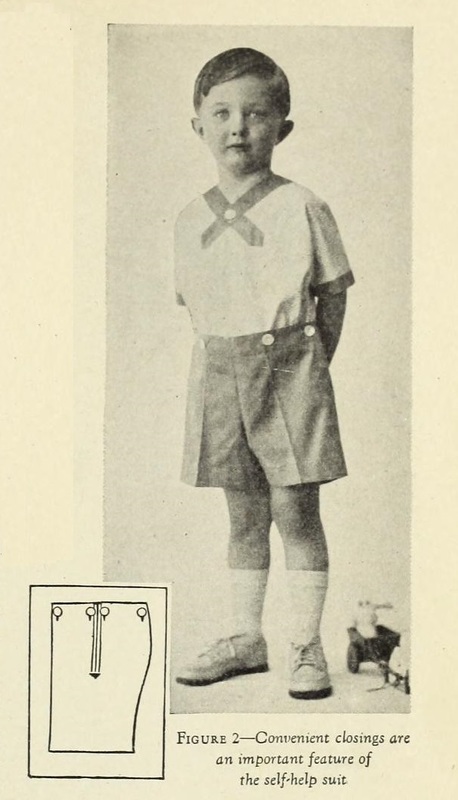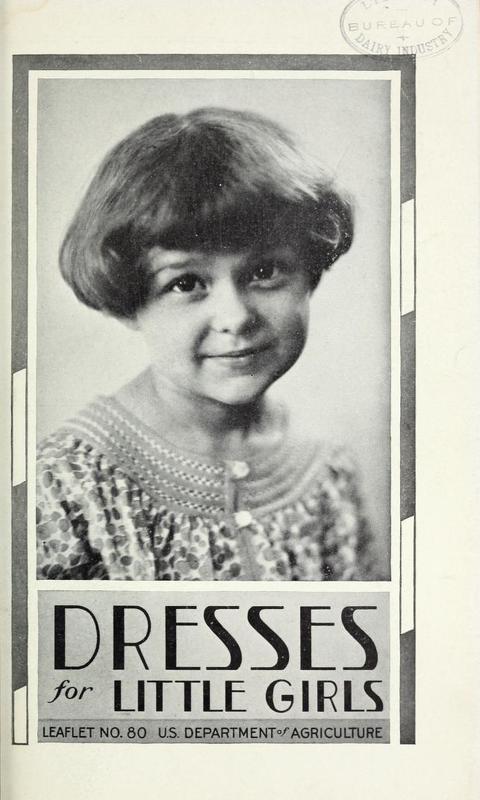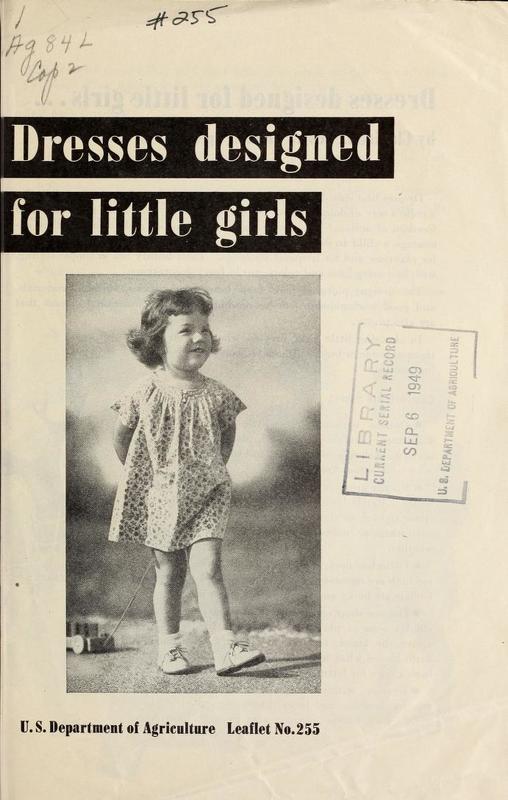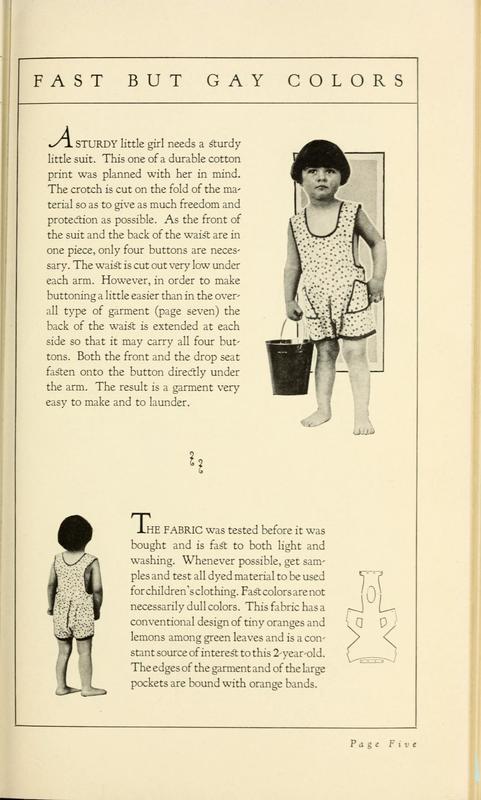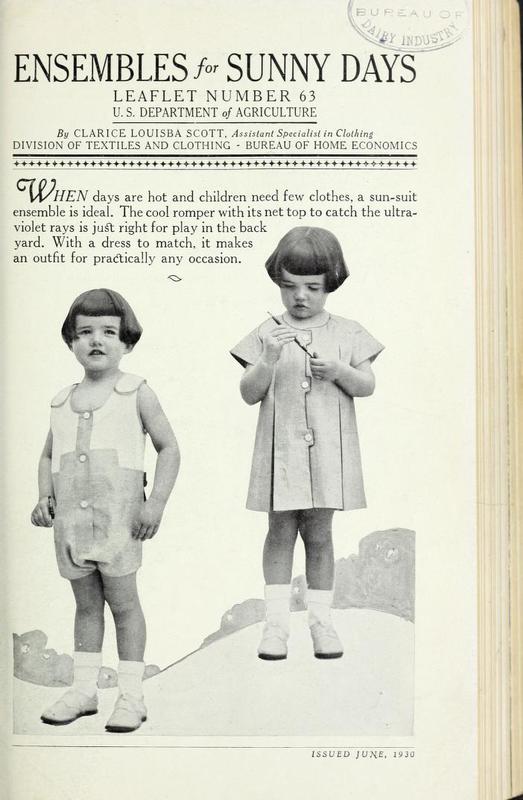Self-Help Children's Clothing
[R]ecently the clothing specialists, the child psychologists, and the physiologists and various other ists have, been doing their best to convince us that the general principles of planning and choosing and making children's clothing are a whole lot different from the general principles that apply to adults' clothing. As we have gained better understanding of childhood, we have come to realize that the first principle of designing children's clothing is to plan garments that permit all parts of the child's body to move freely. Children's clothes should have as few construction lines as will give good fit, as they are not only the most comfortable, but also easy to make and easy to keep clean.
-- Edith Rhyne and Jean Stewart. (1932). Clothing for the Small Child: A Radio Talk. U.S. Department of Agriculture.
Here are some specific designs from the Bureau illustrating clothing that "moves freely, gives good fit, is comfortable and easy to clean."
(Click any image to access full text)
Slips
Fabrics and Designs for Children's Clothes (1937)
Scott, Clarice Louisba and Smith, Margaret
Farmers' Bulletin Number 1778, p.6
"Slips for daytime wear are toe length and wide at the lower edge so as to permit a baby to kick and develop his leg and body muscles. His arms and shoulders are equally free in sleeves of a roomy raglan style cut short if the temperature permits, otherwise long and adjustable at the wrists. Slips of this type also make it possible to use more or less underwear as needed without interfering with the comfortable fit of the clothes."
Bibs
Fabrics and Designs for Children's Clothes (1937)
Scott, Clarice Louisba and Smith, Margaret
Farmers' Bulletin Number 1778, p.23
"A bib can be even more than a protector of clothes. If designed so that a child can put it on and take it off with little or no help it can be just as effective in teaching self-reliance as is learning to handle a spoon or cup.
The self-help design shown here is cut from a piece of cotton ratine 18 by 12 inches, making it possible to get three bibs from one-half of a yard of 36-inch material. The neck is cut deep and round so as to fit closely."
Rompers
Children's Rompers (1927)
Davis , Mary Aleen
U.S. Department of Agriculture Leaflet Number 11
"When the child first begins to investigate the world 'on his own,' rompers are a necessity. A child does not have the best opportunity of developing his body and disposition if he gets tangled up in a dress and petticoat every time he starts to creep. The romper is the child's overall and can be worn by both boys and girls up to 6 or 8 years of age. It protects the underwear and keeps the soil on an outside layer which can be easily peeled off. This cuts down laundry without irritating commands to keep out of the dirt."
Rompers (1931)
Scott, Clarice Louisba
U.S. Department of Agriculture Leaflet Number 79
"Self-Help Rompers
When babies are venturing to take their first; steps they are also learning to do things with their hands as well as their feet. Toys are not the only means with which to encourage manipulation. Everyday play clothes that are easy to put on and to fasten are excellent for this purpose and also teach self-reliance"
Boys' Suits
Suits for the Small Boy (1930)
Scott, Clarice Louisba
U.S. Department of Agriculture Leaflet Number 52
"Self Help Suits Aid in Child Training
The fact is often overlooked that boys' suits offer opportunities for mental as well as physical development. The boy of 2 or 3 has reached the age when he likes to learn new activities and to be independent. A mother should keep this in mind when selecting suits. Simple front openings with buttons and buttonholes that are easily manipulated, uniform in size, and always in the same convenient place, make it possible for a boy to dress himself at an early age. Pull'over sweaters and blouses, complicated belts, and the all-too common type of suit with more than a dozen buttons are a distinct discouragement to self-help."
Girls' Dresses
Dresses Designed for Little Girls (1931)
Scott, Clarice Louisba
U.S. Department of Agriculture Leaflet Number 80
"Little Girls Can Learn to Dress Themselves
Child study has suggested some changes in little girls' dresses. It has found that children may learn self-reliance and independence through such ordinary everyday tasks as putting on, fastening, and removing their own clothes. To encourage this, the styles should be so simple and the way of putting them on so reasonable that mistakes will be next to impossible.
Openings should always be in about the same place. Dresses cut in coat or smock style with full-length front openings similar to Figure 1 are probably the easiest to manage, but others that slip on over the head and fasten at the center front (fig. 2) are not difficult, provided the placket is sufficiently long. Buttonholes or loops should be firm and large enough to slip into place without trouble."
Dresses Designed for Little Girls (1949)
Scott, Clarice Louisba
U.S. Department of Agriculture Leaflet Number 255
"Self-help features
• Neck openings big enough for a child's head to go through without strain. If openings are too short, it's hard to get dresses on and off, and plackets soon tear. Front openings are most easily managed.
• Easy-to-use fasteners — as few as will make a secure closing. Medium - sized, flat buttons with an edge groove are usually easiest for little fingers to hold onto. Sashes and ties call for the help of grown-ups."
Sun Suits
Sun Suits for Children (1928)
O'Brien, Ruth
U.S. Department of Agriculture Leaflet Number 24
"A sturdy little girl needs a sturdy little suit. This one of a durable cotton print was planned with her in mind. The crotch is cut on the fold of the material so as to give as much freedom and protection as possible. As the front of the suit and the back of the waist are in one piece, only four buttons are necessary. The waist is cut out very low under each arm. However, in order to make buttoning a little easier than in the over- all type of garment (page seven) the back of the waist is extended at each side so that it may carry all four buttons. Both the front and the drop seat fasten onto the button directly under the arm. The result is a garment very easy to make and to launder."
Ensembles for Sunny Days (1930)
Scott, Clarice Louisba
U.S. Department of Agriculture Leaflet Number 63
"Sun-suit ensembles are not only convenient and comfortable; they are healthful. Advantage may be taken of the sunlight at any time, and the outer garment may be put on quickly when needed. Energy needed for growth is not wasted by allowing the child to become either too warm or chilly."
Snow Suits
Play Suits for Winter (1929)
Morrison, Bess Viemont
U.S. Department of Agriculture Leaflet Number 54
"Children's clothing must be comfortable. All their garments, especially play suits, should permit freedom and natural movement of the body. Now that outside exercise is being emphasized more and more, clothes which will keep the youngster warm on a cold day and still allow freedom in play are in great demand. The weight of these garments must be as light as possible, because too heavy clothing does not encourage play and may cause posture defects. The choice of a fabric is very important in determining the actual weight of the garment, but the selection of a design which will allow free movement and an even distribution of weight is equally necessary."
Overalls
Child's Self-Help Overalls (1948)
Scott, Clarice Louisba
U.S. Department of Agriculture Leaflet Number 25
"For children's playtime when clothes have to "take it," overalls are the choice of mothers and youngsters alike. An overall planned with a child's needs in mind, like the one pictured, is designed for freedom in play and easy dressing and undressing without help of grown-ups.
• Room for stooping. Children often play in a squatting position, so overalls need extra seat length. This may be provided by setting in small pleats at the bend of the hips, as shown in the overall below.
• Shoulder straps that stay up. Built-up back as well as front, plus straps set to fit the slope of shoulders — this is an arrangement that keeps straps from sliding off and hampering the arms.
• Legs a safe width. A child needs overalls with legs wide enough for easy knee bends but not so wide they cause him to trip and fall.
• Easy to put on. Anchoring shoulder straps so they can't get out of hand is one way to make overalls easy for a child to put on and take off alone. Mother buttons the strap ends inside the waist before the overall is put on. There's no need to unfasten these buttons again until washday. The child merely steps into the overall, pulls it up, and slips an arm under each shoulder strap. Then he has only to button the easy-to-reach buttons at top of bib and sides."
 An official website of the United States government.
An official website of the United States government.


